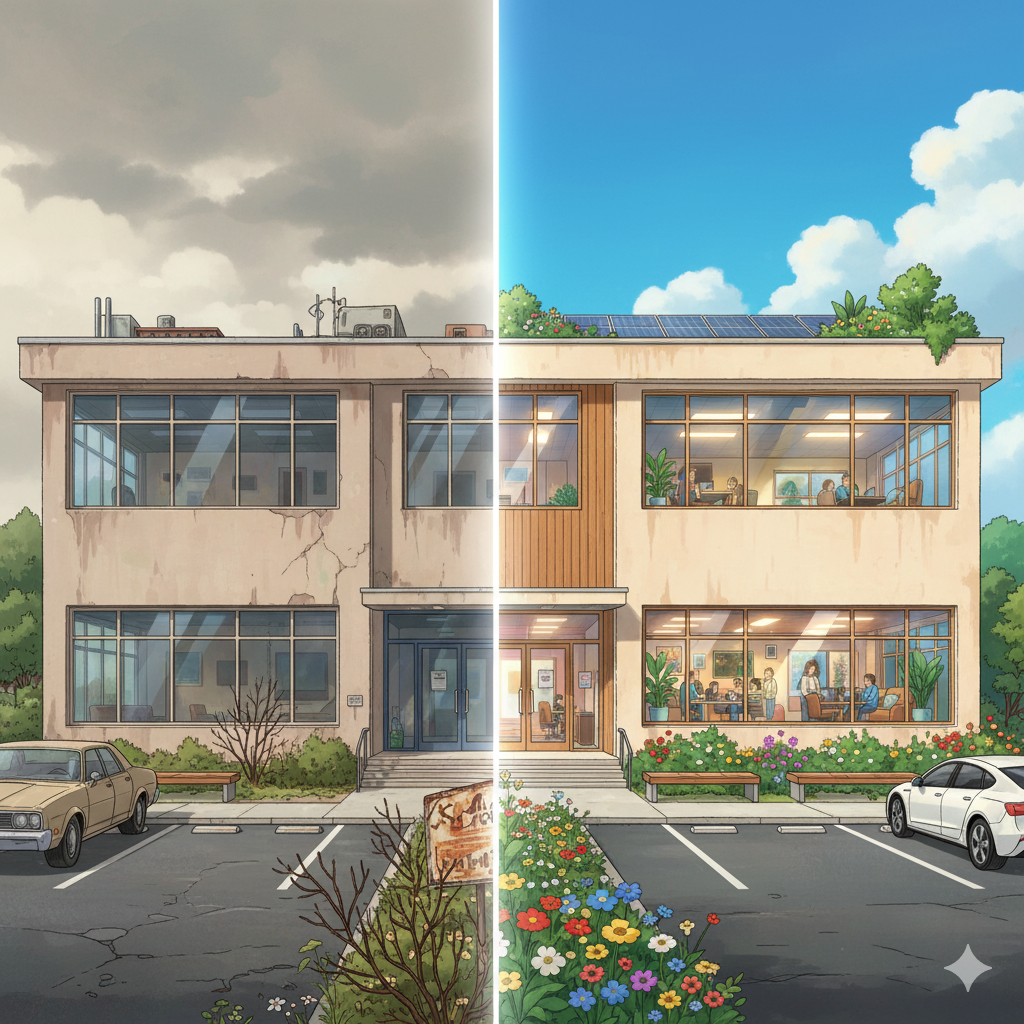
Insights. Expertise. Innovation.
The Collision of AI and Hybrid: Why Static Offices Are Becoming Stranded Assets
In commercial real estate and facility management, we are currently witnessing a collision between two massive tectonic shifts.
On one side, we have Mandated AI Proficiency, where employers are aggressively upskilling teams to leverage automation and augmentation. On the other, we have the solidified reality of Hybrid Work Models, which have fundamentally broken the traditional "one-bum-per-seat" metric of office utilization.
Are these trends in conflict? No. In fact, they are mutually reinforcing.
However, they share a common enemy: The Static Office.
If your building was designed for the workflows of 2019, it is not just outdated; it is rapidly becoming a financial liability. To survive this convergence, we must stop building "offices" and start designing Agile Workplaces.
The Infrastructure Gap: The Problems with AC Power in the Age of AI
The commercial office sector faces a silent crisis. While the headlines focus on the software capabilities of Artificial Intelligence, a physical reality is colliding with legacy building infrastructure: AI hardware is power-hungry, hot, and physically demanding.
Most commercial office buildings were designed for the "ultrabook era"—a time of decreasing power consumption where a 65-watt laptop and a single monitor were the standard. That era is over. The deployment of AI-ready workforces creates two distinct classes of power users, neither of which is well-served by standard AC infrastructure.
To determine if AC-powered workstations are functional, safe, and practical, we must first distinguish between the two types of occupants in an AI-intensive workplace: the AI User and the AI Creator.
The Algorithmic Mandate: Workforce Transformation, Physical Infrastructure, and the Continuous Learning Paradigm in the Age of Agentic AI
The integration of Artificial Intelligence (AI) into the global corporate infrastructure has transitioned from a phase of experimental adoption to a period of structural, non-negotiable mandate. Recent strategic pivots by global consulting leaders, most notably Accenture, have signaled the dissolution of the traditional employer-employee social contract, which historically prioritized tenure and generalist adaptability. The explicit declaration that employees who fail to acquire AI proficiency will be "exited" marks a definitive turning point in workforce management strategy.
This report provides an exhaustive analysis of this transition, investigating the depth of these policies, the resultant restructuring of physical and digital workspaces, and the emergence of a continuous learning ecosystem designed to mitigate rapid skill obsolescence.
This analysis posits that the demand for AI proficiency necessitates a radical reimagining of the corporate environment. If the workforce must be AI-capable, the environment must be robustly designed to support high-compute, high-context workflows. This necessitates the deployment of multi-monitor "cockpit" configurations, agile spatial layouts, and high-performance local hardware capable of running large language models (LLMs) and agentic systems. Furthermore, we examine the lifecycle of AI skills, arguing that "learning AI" is not a static milestone but a continuous, rapid-cycle process that is redefining corporate training infrastructure and reviving the need for physical, on-site centers of excellence.
⚡ The New Power Play: Why August Berres’ Juce Charging Carts are a Game-Changer for Asset Value
In today’s commercial real estate (CRE) landscape, the demand for truly agile, flexible office space has never been higher. Yet, the old electrical infrastructure—a costly, inflexible network of fixed outlets—remains the single biggest roadblock to creating the Agile Workplace.
August Berres has just unveiled a powerful solution to this problem: the new Juce charging cart series, available in 6-place, 12-place, 18-place, and 24-place configurations. This isn't just a cart; it’s a dual-powered, high-speed energy hub that redefines how building owners can monetize and manage their most valuable asset—their space.
The Zero TI Secret: From Vision to Valuation, Design Principles for an Agile Retrofit
In today's commercial real estate (CRE) market, where retrofitting buildings is the primary driver of modernization, the traditional Tenant Improvement (TI) model has become a financial liability. The cost, time, and waste associated with fixed construction actively diminish a building’s value every time a tenant moves or reconfigures.
The Zero TI Retrofit is a critical strategy that transforms a static building into a perpetually Agile Workplace platform. By intelligently deploying innovative technologies such as fault-managed power (FMP) and battery-powered Agile Furniture, this framework permanently eliminates future tenant-specific construction. This approach guarantees a more profitable, valuable, and tenant-friendly asset by prioritizing flexibility, technological integration, and a dramatic reduction in operational friction.
The 83% Crash: Why the Assigned Desk is Extinct and How Agile Retrofits Will Unlock Profit
The era of 1:1 assigned desks is over, marking a profound strategic shift in commercial real estate. In the last five years, the percentage of companies using traditional, assigned seating has plummeted from an estimated 83% to around 55% today, a trend driven by hybrid work and the undeniable financial imperative for efficiency.
Why Your Building Occupancy is Low: Your Organization Changed, But Your Facility Didn't
Low office occupancy is a clear symptom of a critical financial misalignment: your static building is failing your dynamic, modern tenant. Our deep research confirms that organizational change is not an anomaly but the norm, with the average organization undergoing five significant transformations every three years. Furthermore, the accelerating adoption of AI is predicted to amplify this need for rapid internal restructuring.
How a Battery-Powered Agile Workplace Transforms Value, Persona by Persona
The true disruption of the Agile Workplace is not the furniture itself, but the financial model it creates by untethering power from the floorplan. By embracing intelligent power solutions and battery-powered Agile Furniture, the traditional costs and roadblocks of a retrofit dissolve, creating a new, compelling value proposition for every stakeholder.
The $2.4 Million Value Proposition: Why Agile Workplaces Are the New ROI Engine for Suburban Office Retrofits
In the current commercial real estate landscape, traditional Class B/C suburban office assets are under immense financial pressure. However, forward-thinking investors are recognizing a massive, overlooked opportunity: transforming these obsolete properties into high-demand Agile Workplaces.
The key to unlocking this value is a targeted investment strategy that bypasses the crippling costs of conventional electrical retrofits by deploying flexible, battery-powered infrastructure. This strategy delivers a highly profitable, valuable, and tenant-friendly asset.
The Inevitable Pivot: Why Commercial Interior Designers Must Embrace the Agile Workplace
The commercial interior design landscape is undergoing a profound transformation. What began as a trend towards more flexible spaces has solidified into an imperative: the Agile Workplace. For commercial interior designers, this isn't just another design style; it represents a fundamental shift in how value is created, delivered, and perceived by clients. The benefits of Agile Workplaces are so compelling, so deeply intertwined with the financial and operational health of modern businesses, that a pivot in a designer's career focus is not just advisable, it’s increasingly inevitable.
The Profitable History of Movement: From Flexible Theory to the Agile Workplace Imperative
The concept of freeing the worker from a fixed desk is a six-decade-old idea, tracing back to German and Dutch thought leaders who sought efficiency, not just comfort. This history shows a consistent tension between an ideal and the limitations of building infrastructure. While Flexible Working addressed when and where a person works (hours, home vs. office), the more recent Agile Workplace defines the how, requiring a complete redesign of the physical space to support different activities—focus, collaboration, or learning.
This final shift from theory to mandatory practice only happened when the pandemic exposed the massive financial cost of static, underutilized real estate (often up to 50% waste). For building owners and design professionals, the story of agility is the story of finally deploying the technology—like battery-powered Agile Furniture—to achieve the long-desired financial benefit: transforming the expense of immovable infrastructure into the profitable, customizable utility tenants demand.
The Multi-Million Dollar Drain: How Inflexible Office Spaces Become Financial Sinkholes
Static commercial office buildings are plagued by a hidden, multi-million-dollar financial drain: stranded electrical assets. The mean occupancy for a typical commercial office tenant in the US hovers around 3 to 5 years, with some tech leases being even shorter.
Each time a tenant turns over, the existing, hard-wired electrical and data infrastructure becomes a "sunk cost," often useless to the next occupant. Tearing out and replacing this stranded electrical system—part of a full renovation that can cost $100 to $200+ per square foot—is a massive, repetitive expense.
By contrast, technologies such as fault-managed power (FMP) and battery-powered Agile Furniture bypass this demolition and re-wiring roadblock, making reconfigurations as simple as moving furniture. This shift converts a multi-million-dollar liability into an Agile Workplace asset, saving building owners and tenants millions over the building’s life cycle by eliminating costly and disruptive overhauls.













